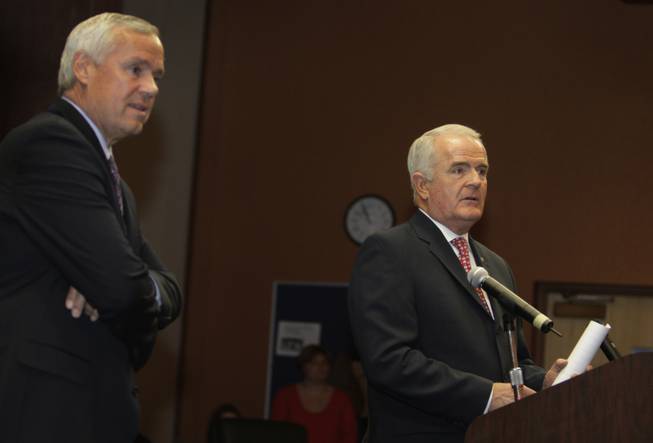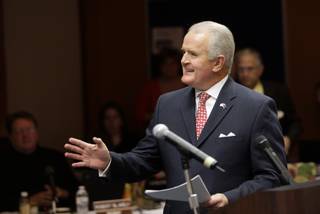
Chancellor Dan Klaich, left, stands by Governor Jim Gibbons during a regents meeting at the College of Southern Nevada, Charleston campus Thursday, March 3, 2010.
Saturday, March 6, 2010 | 2:01 a.m.

Jim Rogers
Sun Coverage
Sun archives
- Gibbons outlines six-step plan for higher education (3-4-2010)
- Budget gets OK as session ends; sales tax extended for roads (3-1-2010)
- Education cuts could mean bigger class sizes (2-28-2010)
- Please, sir, may we tax you more? (2-27-10)
- Lawmakers say progress made in closing state budget shortfall (2-26-10)
- Democrats: Trim education cuts to 5 percent (2-24-10)
- Gibbons’ budget plan risky in an election year (2-24-10)
- Budget crunchtime: Lawmakers set to tackle historic deficit (2-23-10)
On Thursday, Gov. Jim Gibbons unveiled his plan for “an entirely new way of thinking” about how the state’s colleges and universities are funded — with the words italicized in the news release for emphasis.
But in fact, most of the planks in Gibbons’ platform are familiar wood to Nevada System of Higher Education officials, who say they’ve been advocating for similar changes for the better part of a decade.
“People have been talking about these things since the beginning of time,” said Jim Rogers, who retired as chancellor in July. “You don’t get credit for putting it all on one piece of paper.”
During a news conference at the Board of Regents’ meeting Thursday at College of Southern Nevada’s West Charleston Campus, Gibbons told higher ed officials it is his intent to give them “the flexibility and autonomy you’ve always sought ... If there ever was a silver lining to the dark cloud of an economic recession, it’s the reform that comes out (of it). The circumstances of the recession will literally drag some of us to change.”
Board Chairman James Dean Leavitt said the regents have expressed nearly all of the ideas in Gibbons’ plan in recent years and months, with an aim toward making the higher ed system more self-sufficient, effective and efficient.
“We’re glad the governor has a listening ear,” he said.
Gibbons’ plan seeks to:
- Let individual campuses keep control of increases in registration fees and out-of-state tuition.
- Integrate employees in nonteaching positions into the higher ed system and out of the state’s classified personnel system.
- Exempt higher ed capital projects from the control of the State Public Works Board.
- Give regents greater flexibility in spending state dollars, provided additional accountability measures are met.
- Allow the system to keep 25 percent of its unspent general funds each year, instead of having those dollars revert to the state.
- Create a policy in which the system is guaranteed a minimum appropriation to bring greater stability to the long-range planning process.
All of the changes would require approval by the 2011 Legislature.
Rogers told the Sun that changing the state’s tuition structure so that individual campuses retained their revenue was one of the first issues he tackled when he was named chancellor in 2005. He pushed the issue with both Gibbons and his predecessor, Gov. Kenny Guinn.
And he lobbied “damn near every legislator about getting Public Works off our back,” Rogers said. Being subject to the Public Works Board’s regulations significantly drives up the cost of capital projects, Rogers said.
During the recent special session, lawmakers cut education funding by 6.9 percent. The higher ed system’s presidents are preparing to eliminate programs, services and staff as a result.
Gibbons’ list won’t undo the damage that’s currently being done to higher ed, Rogers said, and compared the proposal to “someone beating your brains out and then giving you a napkin to wipe up the blood.”
Acknowledging the severity of the budget crisis, Gibbons told Thursday’s audience: “I would like to stand before you today as governor and tell you that I can and will increase funding to higher education, which I believe is critical to our future and our economy. Unfortunately, we simply do not have the revenue to allow me to make that promise.”
He pledged to work with the Legislature to at least maintain appropriation levels for higher ed, and push for a minimum guarantee on funding to make it easier for the system to do long-range financial planning.
Gibbons said he was in Congress (in 2006) when UNR President Milton Glick suggested to him that each higher ed campus be allowed to keep the student fees they generate, rather than having those dollars revert to the state’s general fund. He supported the idea at the time, and “those discussions many years ago led us to where we are today,” Gibbons said.
Glick said the four-year lag time between his conversations with Gibbons and Thursday’s announcement isn’t unreasonable. A fiscal study needs to be conducted to determine the potential effect to the state’s general fund, as well as whether some campuses might fare better financially under the current funding model, Glick said.
“It’s not as simple as, ‘Let’s just do it,’ ” Glick said Friday. “You have to make sure you don’t create more long-term financial problems. There’s a reason why major public institutions — the higher ed system, the Legislature — take time to change.”
But Leavitt said that if the higher ed system had been allowed to save its unspent general fund dollars, instead of having them revert to the state, it would have almost certainly blunted the effect of the past two years’ budget cuts.
“A rainy-day fund is a good idea for every public agency; it’s a good idea for every family,” Leavitt said. “It’s fiscal prudence.”
Regardless of the freshness of the some of the key concepts in the governor’s plan, “these are good proposals, there’s no question about that,” said UNLV professor John Filler, chairman of the Faculty Senate, who attended Thursday’s regents’ meeting. “But it’s going to take a lot of people working together over a long period of time to make this a reality. Until the Legislature supports these proposals, until the citizenry comes together, until the Board of Regents is able to make this a reality, we’re still at risk.”


Join the Discussion:
Check this out for a full explanation of our conversion to the LiveFyre commenting system and instructions on how to sign up for an account.
Full comments policy